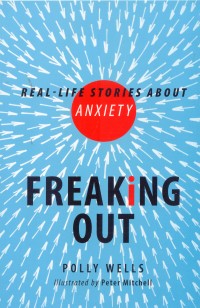| ________________
CM . . .
. Volume XX Number 9. . . .November 1, 2013
excerpt:
Remember the comic strip Bloom County? If so, you might recall that when Binkley opened his bedroom closet, it was the portal to the full range of anxieties: from monsters under the bed to worries about his own future. However, Binkley’s Closet of Anxieties was always a source of gentle amusement. For the 13 young men and women who share their stories in Freaking Out: Real-Life Stories about Anxiety, anxiety is anything but funny. Their situations run the full range from mild phobias (fear of dogs) to disabling disorders which control them completely, making it virtually impossible for them to lead a normal life. The pull quote above describes a reaction which could just as easily be described as fear. All of us have experienced anxiety, and virtually no one is completely fearless. However, Freaking Out makes it clear that there’s a major difference between “fear (response to a known or actual danger or threat) and anxiety, which is the response to a possible or imagined danger or threat.” (1) And for some people, fear metamorphoses into anxiety, and when anxiety starts to control a person, his or her life changes. Noah, for example, became panicked at the mere possibility that he might encounter a dog, and even though he knew there was absolutely no apparent reason for his fear, his anxiety was real. It wasn’t until a vacation encounter with some friendly dogs that he was finally able to deal with them on their own terms, and “come to enjoy a wagging tail.” (29) Others are not so capable at taking charge of their anxieties. The death of her father throws Celia into a tailspin in which every day offers the potential for some type of catastrophic loss. Alana’s lack of confidence, despite her strong academic abilities, made her the target of bullies at her middle school; it wasn’t until she won a scholarship to a private high school that offered her both the opportunity to display her musical talent and the emotional support of an empathic teacher that she was able to surmount her insecurities. Dyscalculia (a learning disorder similar to dyslexia) made every math test a hell on earth for Briony while OCD (obsessive compulsive disorder) behaviours (and parents who refused to acknowledge her problem) made Gita feel as if she was “trapped on a treadmill. . . . totally stuck." (45) Even success can cause anxiety. Ben was a child star, acting in television and theatre, but, as he grew older and the applause faded, he became overwhelmed at the lack of attention and became anxious and unmotivated. Leila, the daughter of two high-powered trial lawyers, was hardwired to be successful: “My mantra is Do well, Do well. It’s what I expect of myself and it’s undoubtedly part of my DNA.” (85) Over time, the pressure made it impossible for Leila to relax: Leila felt like a rubber band about to snap. But, undoubtedly, the saddest story of all was that of Hamid whose “family has lived through years of war, fear, and loss. Anxiety is always with us.” (113) Separated from his family by a sequence of world political events (the war in Afghanistan, 9/11, and so on), his family sends him to Canada. More than a year passes, during which time he has no news of his family, and even when they finally do connect, he worries constantly about their well-being. A return visit to Kashmir finds them living in poverty, and Hamid suffers acute survivor guilt at having escaped their fate. He finally decides to accept the reality that anxiety will always be with him: “[E]ach time I talk to my parents, it seems there is something new to worry about. . . News . . . used to send me into a panic but it doesn’t paralyze me anymore. I’ve learned to tolerate it. I have no choice.” (121) Each of the young people in this book finds a different way of confronting and then dealing with his or her anxiety. For some, a friend, a sympathetic school counselor, or a classroom teacher helps him or her to find the way to manage the problem. Some need professional therapeutic intervention while, for others, time helps to put their situation into perspective. For all, acceptance is necessary, and even if the problem is ongoing, at least they learn to manage. Freaking Out helps an anxious teen see that he or she is not alone, and that there is help. It’s certainly a book that middle and high school guidance counselors can recommend to anxiety-ridden students, although I am not at all certain that it’s a book that anxious students will find and read on their own. Anxiety has a way of paralyzing people into inaction, and it can be really hard to admit to whatever it is that is causing you to “freak out.” Highly Recommended. A retired high school teacher-librarian, Joanne Peters, who lives in Winnipeg, MB, admits to being mildly fearful of flying and big dogs.
To comment
on this title or this review, send mail to cm@umanitoba.ca.
Copyright © the Manitoba Library Association. Reproduction for personal
use is permitted only if this copyright notice is maintained. Any
other reproduction is prohibited without permission.
NEXT REVIEW |
TABLE OF CONTENTS FOR THIS ISSUE
- November 1, 2013.
AUTHORS |
TITLES |
MEDIA REVIEWS |
PROFILES |
BACK ISSUES |
SEARCH |
CMARCHIVE |
HOME |
